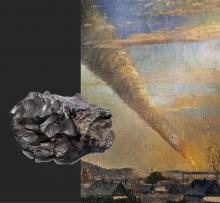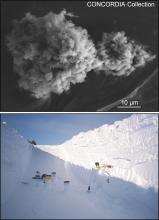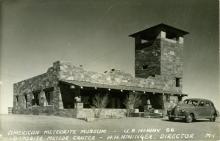Listen to today's episode of StarDate on the web the same day it airs in high-quality streaming audio without any extra ads or announcements. Choose a $8 one-month pass, or listen every day for a year for just $30.
You are here
Bovedy Meteorite
On a spring evening in 1969, Eileen Brown was recording birds in her neighborhood in Bangor, Northern Ireland, not far from Belfast. The birds were interrupted by what sounded like thunder. The sky was clear, though. Instead of thunder, the rumbles were sonic booms. They were produced by a large meteor that was racing across the British Isles. Brown’s recording was the first ever made of a meteor — 50 years ago tonight.
As the meteor sped from southeast to northwest, it was seen by thousands of witnesses. They reported a blue-green or bright white fireball. Many reported that it split apart as it descended over Northern Ireland.
April 25th was a Friday that year. On Monday, a store owner found a hole in his roof and a chunk of rock on his floor — a part of the original space rock, now known as a meteorite. It weighed about 18 ounces.
The same day, a farm owner in County Londonderry found a crater in his field. It contained a meteorite weighing more than 10 pounds. The farm was in an area known as Bovedy. So that became the meteor’s official name.
Today, scientists know that the meteor was a chip off a much larger body. It contains tiny blobs of once-molten rock, known as chondrules. They tell us that the parent body formed at about the time of the birth of the solar system. A collision split it apart. One of its fragments eventually made its way to Earth — and into the history books.
Script by Damond Benningfield





